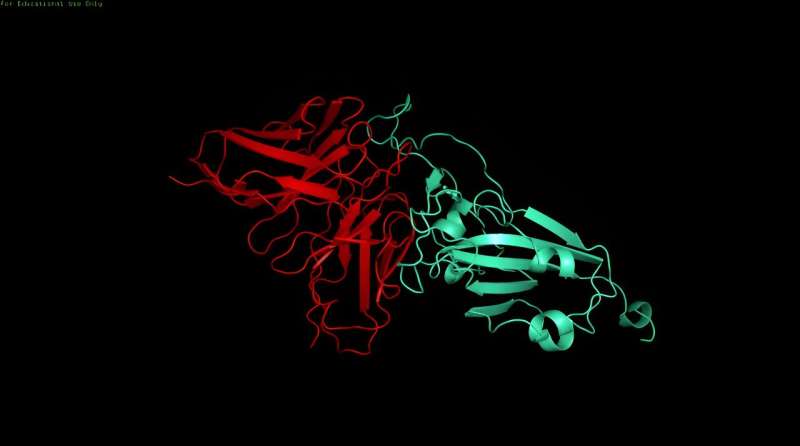This article has been reviewed according to Science X's editorial process and policies. Editors have highlighted the following attributes while ensuring the content's credibility:
fact-checked
trusted source
proofread
Mutations do not predict the severity of current variants of SARS-CoV-2, finds study

New research from UNC Charlotte's Center for Computational Intelligence to Predict Health and Environmental Risks (CIPHER) has found that the two most prevalent strains of the virus that cause COVID-19, SARS-CoV-2 variants BA.2.86 and JN.1, are not significantly better than their predecessor omicron at evading immune responses and causing infections despite having a high number of mutations compared to previous variants.
When first identified, omicron offshoots BA.2.86 and its close relative JN.1 raised significant public health concerns. These concerns were tied to the fact that the original omicron variant was highly mutated, resulting in both immune evasion and breakthrough infection, as well as being more infectious and highly mutated compared to earlier variants.
There was some speculation that large numbers of new mutations in BA.2.86 and JN.1 conferred a greater ability of these variants to evade the human immune system and be more transmissible. Extensive computational analyses conducted by a team of UNC Charlotte scholars and students determined that these variants only had small, statistically insignificant changes in immune evasion and transmissibility infection capacity compared to earlier variants, including omicron.
"These results really surprised me. The fact that omicron, with its large set of mutations, led to greater immune evasion and a surge in cases and hospitalizations was predictable. However, BA.2.86 and JN.1 have yet another large set of mutations, and while we have seen some signals of increased prevalence of these two variants in wastewater and genomic surveillance, there has not been an accompanying large surge in cases or hospital burden," said Daniel Janies, the co-director of CIPHER and the Carol Grotnes Belk Distinguished Professor of Bioinformatics and Genomics in the College of Computing and Informatics.
To assess the immune evasion of BA.2.86 and JN.1, the UNC Charlotte research team performed an extensive in silico analysis on the Receptor Binding Domain (RBD; the region of the viral genome against which vaccines are designed) of SARS-CoV-2, comparing the two newer variants to previous variants to calculate the relative binding affinity of neutralizing antibodies to the RBD from vaccinated patients, infected patients and therapeutic sources.
In addition to antibody analysis, researchers calculated the relative binding affinity of BA.2.86 and JN.1 to Angiotensin Converting Enzyme-2 (ACE2) in comparison to previous variants.
The team found minor changes in binding affinity for neutralizing antibodies and ACE2 for BA.2.86 and JN.1 in comparison to previous SARS-CoV-2 variants. However, those changes were not statistically significant. Therefore, they concluded that BA.2.86 and JN.1 have no significant increase in immune evasion or infection capacity to previous variants.
In explaining their results, the researchers caution that genomic surveillance, which counts mutations or relative prevalence of a variant, does not necessarily reveal the functional and health impacts of the variant.
In the study outlining their research, awaiting publication and available on the bioRxiv preprint server, the team discusses the benefits of their approach to understand the function of variants and the need for future studies to assess variation outside of the RBD for future analysis. Future studies in this area will benefit from an increased focus on antibodies derived from memory B-cells that produce antibodies in response to SARS-CoV-2.
"In patients whose immune systems have been exposed to a previous omicron variant, memory B-cells may provide significant protection for the newer omicron variants BA.2.86 and JN.1," said Shirish Yasa, a current Charlotte bioinformatics and computer science senior who helped conduct this research.
"This protection conferred by memory B-cell-derived antibodies is a process not yet well studied. An increase in omicron targeting memory B-cells via vaccination and prior infection could be a significant factor in the overall reductions we have seen in hospitalizations and deaths for patients exposed to the descendants of the original omicron variant."
This research contributes to the functional understanding of SARS-CoV-2 variants BA.2.86 and JN.1, building on the studies of genomic surveillance. Moreover, this UNC Charlotte effort has introduced new methodologies for functional computational immunology, which will help in the ongoing efforts to mitigate the consequences of the COVID-19 pandemic.
More information: Shirish Yasa et al, Predicting Antibody and ACE2 Affinity for SARS-CoV-2 BA.2.86 and JN.1 withIn SilicoProtein Modeling and Docking, bioRxiv (2023). DOI: 10.1101/2023.11.22.568364


















